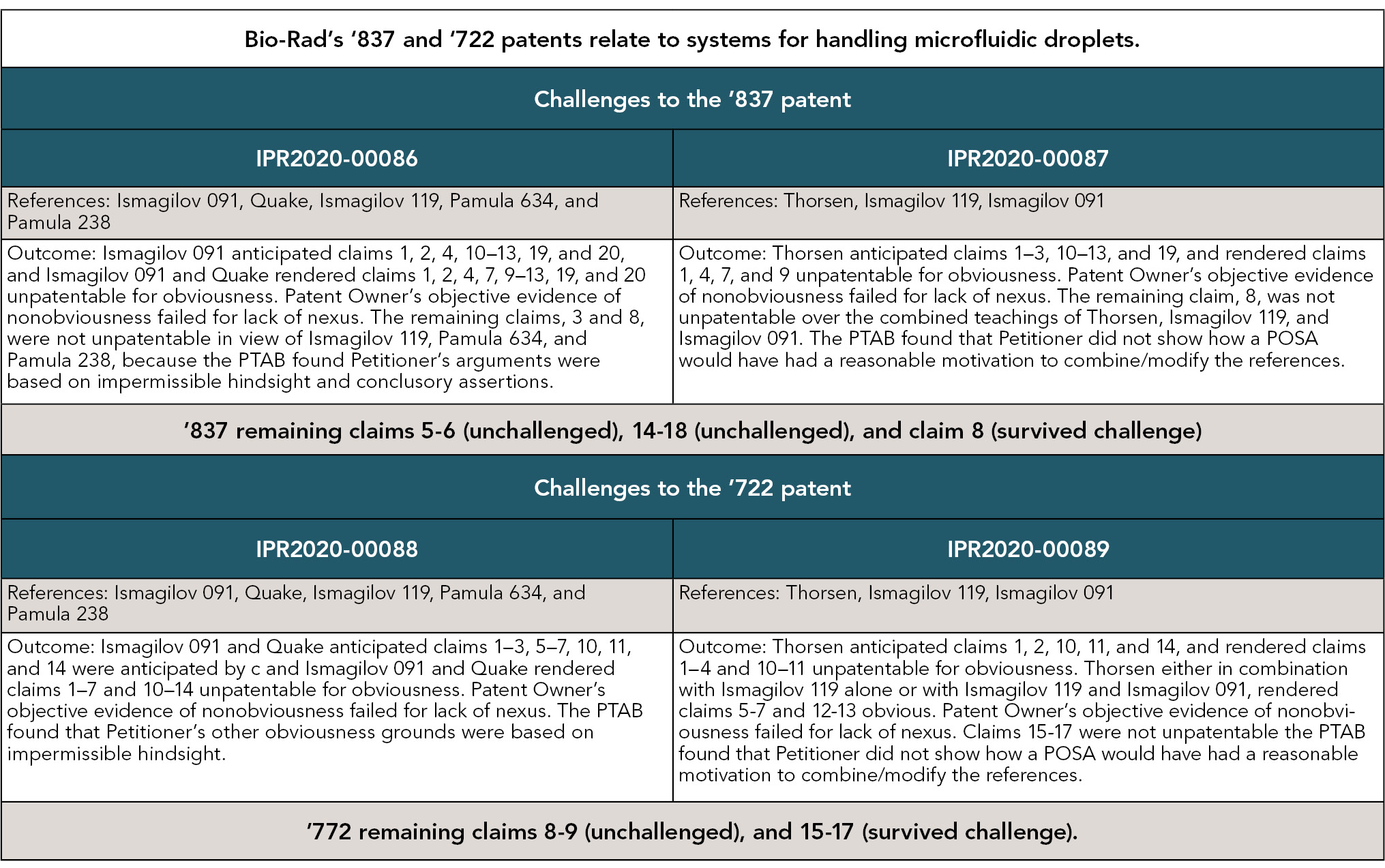Holding
10X Genomics challenged claims in Bio-Rad’s U.S. Pat. No. 9,562,837 (“the ’837 patent) and 9,896,722 (“the ’722 patent”). The PTAB issued four mixed Final Written Decisions in 10X Genomics Inc. v. Bio-Rad Labs., Inc., IPR2020-00086, -00087, -00088, and -00089, finding most claims unpatentable but allowing a few to survive.[1]


In its conclusion in all four FWDs, the PTAB included a most interesting footnote:
Should Patent Owner wish to pursue amendment of the challenged claims in a reissue or reexamination proceeding subsequent to the issuance of this decision, we draw Patent Owner’s attention to the April 2019 Notice Regarding Options for Amendments by Patent Owner Through Reissue or Reexamination During a Pending AIA Trial Proceeding, 84 Fed. Reg. 16,654 (Apr. 22, 2019). If Patent Owner chooses to file a reissue application or a request for reexamination of the challenged patent, we remind Patent Owner of its continuing obligation to notify the Board of any such related matters in updated mandatory notices. See 37 C.F.R. § 42.8(a)(3), (b)(2).
In addition to an obligation to notify the PTAB under Rule 42.8, Patent Owners must also consider the following:
-
Duty of candor in IPRs, 37 C.F.R. § 42.11(a): Duty of candor. Parties and individuals involved in the proceeding have a duty of candor and good faith to the Office during the course of a proceeding.
-
Patent owner estoppel, 37 C.F.R. § 42.73(d)(3): Patent applicant or owner. A patent applicant or owner is precluded from taking action inconsistent with the adverse judgment, including obtaining in any patent:
(i) A claim that is not patentably distinct from a finally refused or canceled claim; or
(ii) An amendment of a specification or of a drawing that was denied during the trial proceeding, but this provision does not apply to an application or patent that has a different written description.
-
PTAB authority to manage multiple proceedings before the Office:
35 U.S.C. § 315(d) Relation to other proceedings or actions.
(d) MULTIPLE PROCEEDINGS. — Notwithstanding sections 135(a), 251, and 252, and chapter 30, during the pendency of an inter partes review, if another proceeding or matter involving the patent is before the Office, the Director may determine the manner in which the inter partes review or other proceeding or matter may proceed, including providing for stay, transfer, consolidation, or termination of any such matter or proceeding.
We understand that this footnote appears regularly now in many PTAB decisions. If a patentee files a reissue application, the “surrender of the original patent shall take effect upon the issue of the reissued patent.” 35 U.S.C. § 252. Have patent owners been filing reissue applications and amending claims to try and get around an IPR decision, but not informing the Board as required under the Board’s mandatory notices?
If the reissue patent issues before the Board’s Final Written Decision issues, the patent challenged in that IPR no longer exists. But this is not likely to be a successful end-run, given that IPRs finish within 12 months of institution (35 U.S.C. § 316(a)(11)) and the average time from filing to issuance for reissue patents is close to 2 years. See Pendency Update and Continuation Practice Data, Andrew Faile, Deputy Commissioner for Patent Operations, August 13, 2020, Patent Public Advisory Committee Quarterly Meeting, p. 3 (“utility, plant, reissue total pendency 23.1 months”).
Alternatively, is the PTAB simply reminding patent owners that there are options even though their patent has been challenged and some claims may be found unpatentable? For example, patentably distinct claims may still be pursued.
Take-Away
Maintaining options as a patent owner by filing continuation applications may help avoid costly reissue or reexamination applications. But whether pursuing claims in continuation, reissue, or reexamination applications, patentees should bear in mind the requirement that any claims pursued must be patentably distinct from a finally refused or canceled claim in an AIA trial proceeding. And in all cases, those filing papers before the Office and the Board should remember to comply with all applicable duties of notice, candor and disclosure.
[1]10X and Bio-Rad are engaged in multiple district court and IPR proceedings on several patents. With respect to the ’837 and ’722 patents, there is a co-pending district court case, but it is stayed.






 />i
/>i

